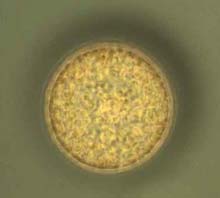Desert dust enables algae to grow

Biologists from the Royal Netherlands Institute for Sea Research have demonstrated that desert dust promotes the growth of algae. Scientists had already assumed that the iron in desert dust stimulated algal growth, but this has now been demonstrated for the first time. The researchers have published their findings in the December issue of the Journal of Phycology.
The biologists cultured two species of diatoms in seawater originating from the iron-depleted Southern Ocean, the sea around the South Pole. The algae were supplied with dust from a desert in Mauritania and a desert in Namibia. The growth of algae which received a lot of dust was compared with that of algae which received little or no dust.
Algae that received desert dust grew considerably better than algae which did not. The researchers also discovered that algae grew less well on desert dust from Mauritania than desert dust from Namibia.
As well as establishing how much iron the dust contained, the researchers also discovered that the algae could only utilise a limited part of the dissolved iron. This was established by culturing the algae in seawater without dust, but with different concentrations of dissolved iron. The researchers could then compare the growth of the algae that received a known quantity of iron with that of the algae which grew on dust.
The researchers will use the laboratory results to predict how algae in the ocean respond to desert dust. The data obtained from these predictions will contribute to knowledge about the further development of the greenhouse effect, because algae absorb the greenhouse gas carbon dioxide and in so doing slow down the warming up of the Earth.
For further information please contact Dr Klaas Timmermans (Royal Netherlands Institute for Sea Research), tel. +31 (0)222 369494, fax +31 (0)222 319674, e-mail: klaas@nioz.nl.
The complete study will be published in the Journal of Phycology, December 2003, Volume 39 (6), under the title: The role of the reactivity and the content of iron of aerosol dust on growth rates of two Antarctic diatom species. F. Visser, L.J.A. Gerringa, S.J. Van der Gaast, H.J.W. de Baar, K.R. Timmermans.
Image available at www.nwo.nl/news.
The research was funded by the Netherlands Organisation for Scientific Research, the EU and the Royal Netherlands Institute for Sea Research.
Media Contact
More Information:
http://www.nwo.nlAll latest news from the category: Life Sciences and Chemistry
Articles and reports from the Life Sciences and chemistry area deal with applied and basic research into modern biology, chemistry and human medicine.
Valuable information can be found on a range of life sciences fields including bacteriology, biochemistry, bionics, bioinformatics, biophysics, biotechnology, genetics, geobotany, human biology, marine biology, microbiology, molecular biology, cellular biology, zoology, bioinorganic chemistry, microchemistry and environmental chemistry.
Newest articles

First-of-its-kind study uses remote sensing to monitor plastic debris in rivers and lakes
Remote sensing creates a cost-effective solution to monitoring plastic pollution. A first-of-its-kind study from researchers at the University of Minnesota Twin Cities shows how remote sensing can help monitor and…

Laser-based artificial neuron mimics nerve cell functions at lightning speed
With a processing speed a billion times faster than nature, chip-based laser neuron could help advance AI tasks such as pattern recognition and sequence prediction. Researchers have developed a laser-based…

Optimising the processing of plastic waste
Just one look in the yellow bin reveals a colourful jumble of different types of plastic. However, the purer and more uniform plastic waste is, the easier it is to…



